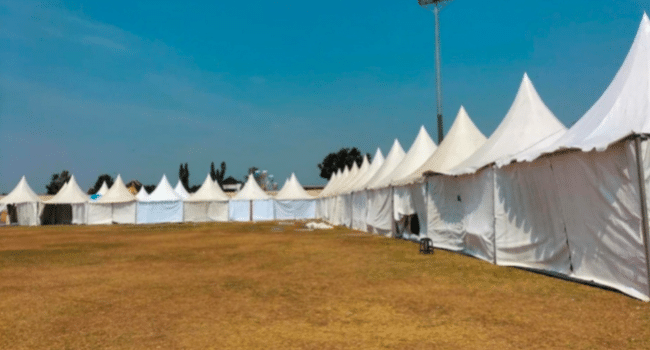Table of Contents
Pop-up tents are now a staple in the contemporary marketplace of trade shows, outdoor markets, and brand activations. Pop-up tents create a portable and professional platform that offers brand customization and provides a visible space for brands to enhance their visibility instantly. Printed tents, where they are used, can even be set up with efficiency by following these tips towards a more professional look and greater stability. Learning the setup process can save businesses time and money and offer a safer and more welcoming atmosphere for any business wanting to carry out outdoor activities after being successful at an event.
Steps for Quick and Secure Tent Assembly

- Choose the Right Location and Food Vendor Tents Layout
A safe setup begins with proper site selection. A flat, solid floor reduces the probabilities of instability or being structurally out of balance. Steer clean of unfastened soil, choppy terrain, or excessive slope. When making plans out of doors markets and exhibitions, you could bear in mind merging format making plans and utility. For example, food vendor tents should be located in a visible location so that attendees can access them easily and have enough area for ventilation and foot traffic throughout the location.
Showcase tents or tents hosting client meetings should be placed away from locations that serve food or highly trafficked areas to reduce the chance of attendees taking the event less seriously. Layout planning should aid in the ability to attend to public flow while providing access to both customers and staff at the event.
- Prepare and Inspect All Components
Before construction, collect all parts: frame, canopy, stakes, ropes, side walls, and connectors. Having any one part missing or damaged can impact the functionality and stability of your whole tent. Spread the whole lot out properly in a smooth and open place, and test for wear, rust, or bent steel portions.
If the body joints appear stiff, gently lubricate them, and ensure that the material panels are not damp or torn. Preparation reduces the time for setup and minimizes capacity fitness and safety risks. Event organizers regularly preserve spare connectors and ropes to rectify any unforeseen problems that stand up in assembly.
- Assemble the Frame with Care and Precision
To commence the expansion of the tent frame, it’s best to do so evenly with two or more people if it is a larger model. With some pulling outward from the opposite corners, soon enough, the frame should open up. Do not be too enthusiastic in pulling; each step should be done carefully to avoid bending or jamming the joints. Once the tent frame is expanded to approximately halfway, suit up the toolbar by putting the canopy on the frame and aligning the canopy corners directly with the frame legs.
Continue to expand and lock the tent frame into place.After the corners are locked, you may want to double-check that each hinge has clicked up firmly. This is important to make certain that the tent canopy strains up and the canopy is stretched frivolously throughout the frame, imparting a polished, expert look that reflects your logo photograph positively on the event
.
- Anchor and Stabilize Against Wind
A pop-up tent is best as stable because the anchoring, regardless of how properly the setup is accomplished. Use stakes, ropes, or weighted bags to stable the tent, depending at the ground and weather conditions. On a concrete or asphalt floor, use sandbags or heavy barrels, with every barrel tied to the leg of the tent. On grass or dirt, you must location the stakes inside the floor at a 45-diploma attitude for better hold.
If the wind is blowing, you must additionally use additional man strains to brace the frame on any tent setup. Failing to brace the body of the tent is one among the most important errors made with outdoor occasions concerning tents, leaving you with a damaged tent or, even worse, a doubtlessly dangerous scenario.
- Final Adjustments and Safety Checks
After erecting and stabilizing the tent, complete a surface visible inspection. Confirm that the cover fabric is taut and freed from wrinkles due to the fact drooping regions will keep water or area pointless strain at the material. Look for wobbling legs or joints, tighten any connections, and check to make sure that stakes or weights are secure.
Finally, attach sidewalls, banners, and interior objects to avoid any interference throughout setup. Any electric cords or lighting systems ought to be effectively insulated and far from walking paths. A well anchored tent will preserve up against the unpredictable climate and maximize protection for all people internal.
End Point
Speedy, effective, and safe assembly of tents is an important skill for any exhibitor or event organizer. Regardless of whether it’s food vendor tents or a luxurious printed tent, knowing the structure, foresight, and safety plan is part of the smooth execution and structural integrity of any tent. Above all, it is about consistency; every assembly should have a systematic plan with an emphasis on balance, security, and the look of the tent. A tent assembled correctly will protect the equipment and those who visit under it, and it demonstrates the organization’s commitment to professionalism and attention to detail.
Read more on KulFiy
